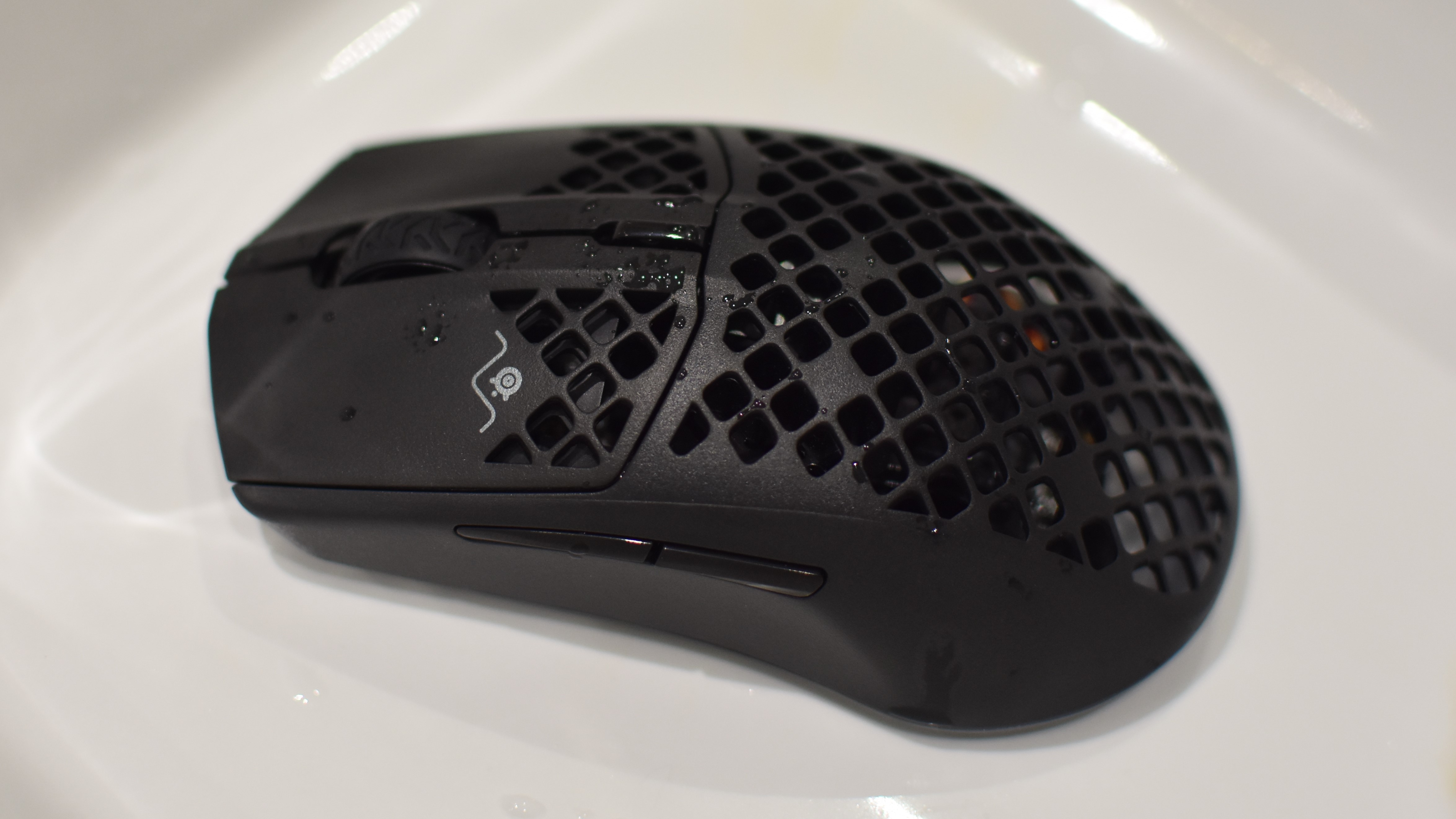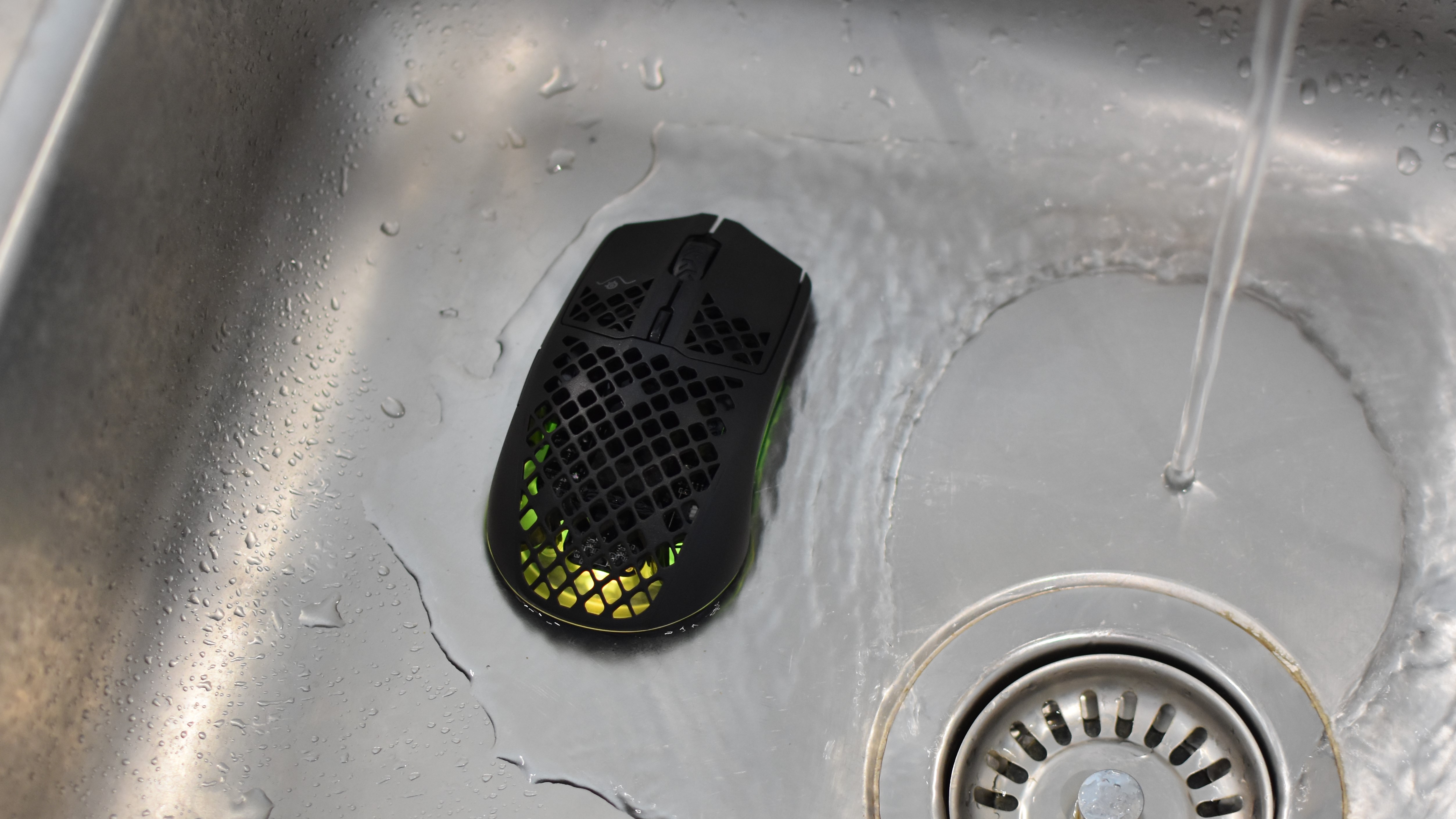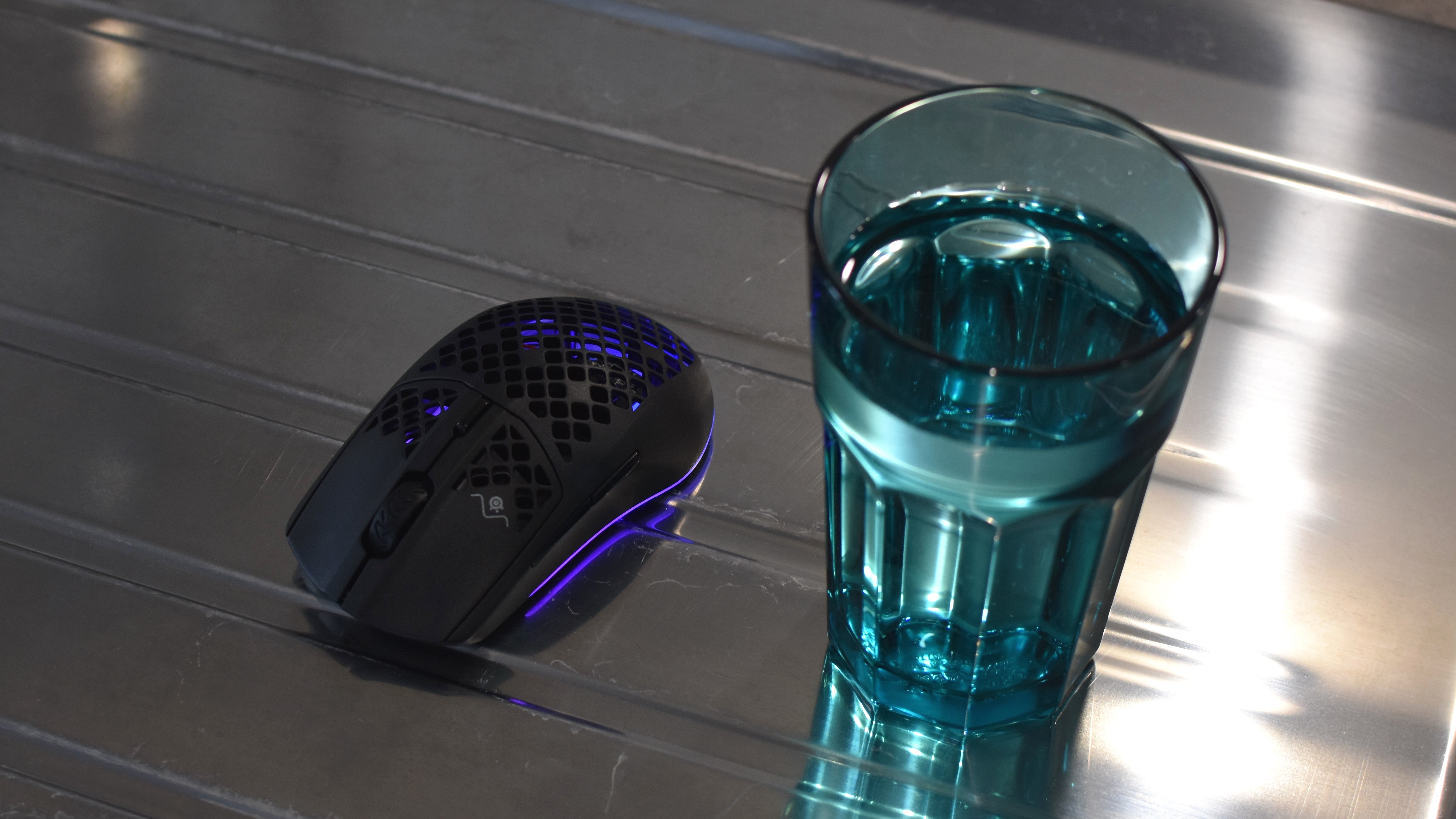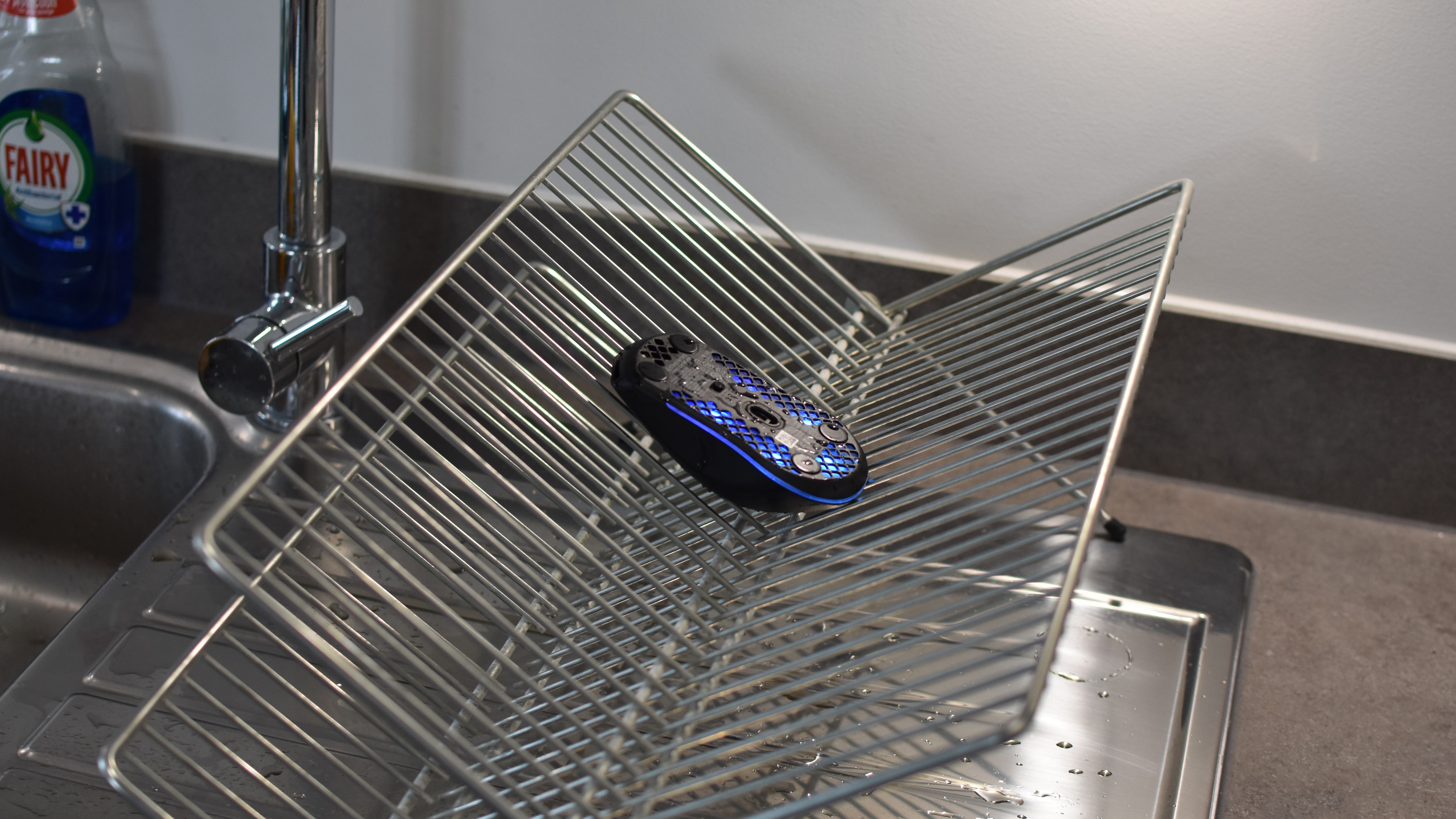However, chronological bragging rights aren’t as immediately curious as how these mice resist spillages when the internal circuitry is so readily exposed by their hole-punched, lightweight frames. The answer is what SteelSeries call AquaBarrier, which appears to be a sort of hydrophobic coating applied to both the outer casing and the components exposed within. This isn’t the only reason why the Aerox 3 and Aerox 3 Wireless are two of the best gaming mice you can buy, but I was curious: how much liquid punishment could one of these rodents actually take? To find out, I took the Aerox 3 Wireless – the more expensive of the two – and set about seeing how its IP-rated protection holds up.
Test 1: A fine mist
The lightest, least threatening moisture test I could think of involved hitting the Aerox 3 Wireless with a spritz from a water spray bottle. Mainly used for humidifying the remaining house plants I haven’t yet killed, this shoots a mist rather than a pressurised jet, so according to the mouse’s IP rating this should have been easy enough to endure. And it was! Without even waiting for the misted innards to dry out, the Aerox 3 Wireless was ready to go immediately. A good start, and good news for those who own both a gaming PC and household horticultural care tools while also being extremely clumsy.
Test 2: Just a splash
Now that the AquaBarrier was warmed up, it was time to test the kind of water encroachment that IP54 specifically covers: splashes. The International Electroctechnical Commission, who came up with these ratings, don’t specify the volume or speed that define “spashes” as a metric, so I started off gently by simply flicking some water at the Aerox 3 Wireless like it was a loved one at a swimming pool. Only worded less weirdly. The water globules were certainly bigger than with the spray bottle, though rather than doing more harm to the mouse internals, this made it easier for the outer shell to stop some in its tracks. After a few flicks, I towelled off the outside, returned to my desk and confirmed that no: playful splashing is not enough to kill an Aerox 3 Wireless. Not even hinder it, from the look of things.
Test 3: Dipping its toes
So far I’d been focusing what happens when water gets in through the cutout holes on top of the Aerox 3 Wireless, but what about when danger comes from below? To simulate the base of the mouse getting marinated in the pool of an adjacent spillage, rather than taking a direct hit, I sat it in a flat sink and let the tap run until the lowest few millimeters were nice and soaked. Again, though, the Aerox 3 Wireless shrugged this off. The optical sensor is evidently protected enough that it continued to work as normal, and the switch that controls whether the mouse uses Bluetooth or 2.4GHz – another component positioned on the underside – showed no signs of water damage either. One difference between this mouse and the HyperX Pulsefire Haste, which is also covered in weight-saving cutouts, is that the Aerox 3 Wireless has a transparent plastic plate just behind the holes on the base. I’m not sure if this is for waterproofing purposes alone, as the plate doesn’t cover a patch of cutouts at the front, but judging how much liquid I towelled off it, the plate does indeed help with blocking out unwelcome ingress.
Test 4: Leaving out in the rain
Test postponed.
Test 5: An actual drink spillage test
Time for the most realistic challenge yet: nothing but the mouse, a glass of Southeast England’s hardest water, and a careless pair of hands. This is probably what SteelSeries had in mind when deciding to slather the Aerox 3 and Aerox 3 Wireless in a water-resistant coating, though looking at that circuit board through the net-like holes, it was hard not to be sceptical. There’s exposed wires in there, man, come on. But no. Even after dropping a healthy glug through the plastic grille, enough that turning the mouse upside-down made the water pour out in streams as if from a colander of just-cooked spaghetti, the peripheral lived. RGB lighting still glowing in defiance, its sensor, buttons, scroll wheel and wireless capability all continued to work. That was true both immediately after a quick pat to dry the outside and later on, when any residual water inside had evaporated. The only annoyance was some holdout flecks hiding in the nooks of the meshy bit, giving me a partially moistened right hand. Strictly speaking, this is vindication enough for what the Aerox 3 Wireless claims to do. An IP54 rating means it provides sufficient protection against non-pressurised water splashes that they won’t interfere with the device’s operation – and it’s not just marketing-speak, as this mouse clearly can survive that kind of water exposure. That said, IP ratings only cover water in its most innocuous forms: fresh, bottled, tap and the like. Could the Aerox 3 Wireless survive a spill from something with more than two chemical elements? Perhaps one last test was in order.
Test 5: Sod it, let’s just pour Diet Coke all over it
It still worked. What else can you say at this point beyond “yeah, alright, fair play”? Not only did I drop enough soft drink (others are available) into the Aerox 3 Wireless to produce a bubbling pool around its vital circuitry, but I even gave it the bonus round of another water rinse afterwards. Which, in my defence, I probably would do if I spilled anything brown on my own peripherals. There was a brief moment of worry when the onboard lighting began spluttering off and on, but after enough of the Coke drained away, it once again shone as normal. You might be able to do more damage by spilling a sugary drink, but there’s enough acid in the “Diet” variety for this to feel like an adequate stress test. And I know because this is the stuff that’s been stealing all my enamel for the past two decades. Full marks to Aerox 3 Wireless, in any case. As finely-crafted as some mice can be, like the new Razer Basilisk V3, it turns out that if you want a truly water-resistant mouse you should get…one that’s full of holes? I guess?







